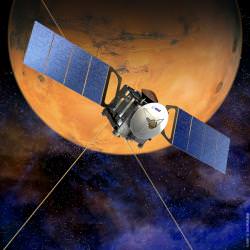When the Phoenix lander hits the Martian atmosphere at over 20,000 km/h, at least it will feel safe in the knowledge that it has three buddies looking out for it. NASA’s Mars Reconnaissance Orbiter and Mars Odyssey are already preparing for Phoenix’s arrival, and now ESA’s Mars Express has been asked to assist in watching the lander’s 13-minute descent.
The Phoenix Mars Mission will land on the Red Planet on May 25th of this year to search for evidence of life on Mars and seek out some good regions for future manned settlements. However, before it can begin its work, Phoenix must dive through the Martian atmosphere at high speed and complete a 13-minute entry, decent and landing (EDL phase). This is a critical part of any planetary lander mission. As highlighted by the British Beagle 2 lander when it separated from Mars Express in 2004, nobody should be complacent about atmospheric reentry.
Flight controllers had already begun adjusting Mars Express’ phase in November last year to optimize its orbit so it can get the best possible view of Phoenix’s entry. Orbital adjustments already had to be made, so NASA’s request did not cost too much in additional fuel.
Using instrumentation intended to track the descent of the ill-fated Beagle 2, Mars Express’ adopted lander will be tracked by the Mars Express Lander Communications system (MELACOM). Mars Express will perform a fast (three-times faster than normal operations) turn on one axis to follow Phoenix flying past and down to Mars. Mars Express will be an essential backup system to NASA’s orbiters, allowing NASA to confirm the correct measurements of speed and trajectory of Phoenix.
Having already been tested, ESA scientists are confident Mars Express will perform excellently:
“Last year, we practised relaying commands from NASA to Mars Express and then down to the surface, using NASA’s Mars Rovers as stand-in for Phoenix. It worked fine.” – Michel Denis, Mars Express Spacecraft Operations Manager.
Either way, the 13-minutes from entry to landing will be nerve-wracking for everyone involved, but it’s good to know the NASA and ESA missions already in orbit around Mars will be able to give a helping hand to the Mars rookie.
Source: ESA


There’s a slight difference between ‘decent’ and ‘descent’. Let’s hope the craft makes a decent descent anyway 🙂
When Phoenix lands, it will find things never imagined. Let hope we are ready for it.
PEACE AND LOVE
Scott
Thanks AndyF! Spelling was never my forte… but still, I hope she makes a decent descent!
Cheers, Ian
Pheonix if it arrives safely,should answer alot of question ,can’t wait for it to gt there and begin doing science
A Mars First-er would offer a decent descent dissent.